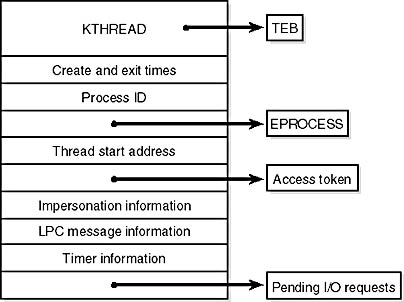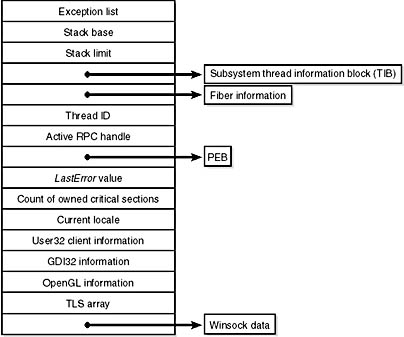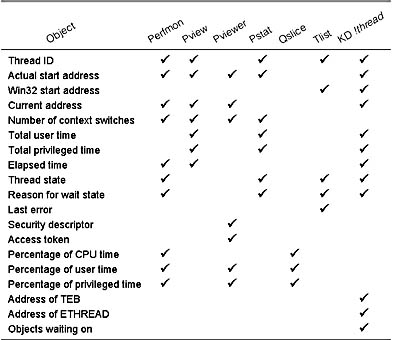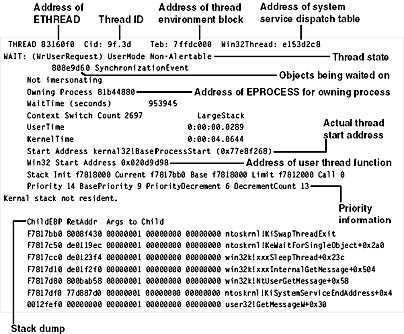Thread Internals
Now that we've dissected processes, let's turn our attention to the structure of a thread. Unless explicitly stated otherwise, you can assume that anything in this section applies to both normal user-mode threads and kernel-mode system threads (described in Chapter 3).
Data Structures
At the operating system level, a Windows 2000 thread is represented by an executive thread (ETHREAD) block, which is illustrated in Figure 6-7. The ETHREAD block and the structures it points to exist in the system address space, with the exception of the thread environment block (TEB), which exists in the process address space. In addition, the Win32 subsystem process (Csrss) maintains a parallel structure for each thread created in a Win32 process. Also, for threads that have called a Win32 subsystem USER or GDI function, the kernel-mode portion of the Win32 subsystem (Win32k.sys) maintains a per-thread data structure (called the W32THREAD structure) that the ETHREAD block points to.

Figure 6-7 Structure of the executive thread block
Fibers vs. ThreadsFibers allow an application to schedule its own "threads" of execution rather than rely on the priority-based scheduling mechanism built into Windows 2000. Fibers are often called "lightweight" threads, and in terms of scheduling, they're invisible to the kernel because they're implemented in user mode in Kernel32.dll. To use fibers, a call is first made to the Win32 ConvertThreadToFiber function. This function converts the thread to a running fiber. Afterward, the newly converted fiber can create additional fibers with the CreateFiber function. (Each fiber can have its own set of fibers.) Unlike a thread, however, a fiber doesn't begin execution until it's manually selected through a call to the SwitchToFiber function. The new fiber runs until it exits or until it calls SwitchToFiber, again selecting another fiber to run. For more information, see the Platform SDK documentation on fiber functions.
Most of the fields illustrated in Figure 6-7 are self-explanatory. The first field is the kernel thread (KTHREAD) block. Following that are the thread identification information, the process identification information (including a pointer to the owning process so that its environment information can be accessed), security information in the form of a pointer to the access token and impersonation information, and finally, fields relating to LPC messages and pending I/O requests. As you can see in Table 6-9, some of these key fields are covered in more detail elsewhere in this book.
Table 6-9 Key Contents of the Executive Thread Block
| Element | Description | Additional Reference |
|---|---|---|
| KTHREAD block | See Table 6-10 | |
| Thread time information | Thread create and exit time | |
| Process identification | Process ID and pointer to EPROCESS block of the process that the thread belongs to | |
| Start address | Address of thread start routine | |
| Impersonation information | Access token and impersonation level (if the thread is impersonating a client) | Security (Chapter 8) |
| LPC information | Message ID that the thread is waiting for and address of message | Local procedure calls (Chapter 3) |
| I/O information | List of pending I/O request packets (IRPs) | I/O system (Chapter 9) |
For more details on the internal structure of an ETHREAD block, you can use the kernel debugger !threadfields or !kdex2x86.strct ethread command to display the offsets in hexadecimal for almost every field in the structure. Although many of the field names are self-explanatory, the output doesn't give the data type of the fields, nor does it show the format of the structures that are included within or pointed to by the ETHREAD block.
Let's take a closer look at two of the key thread data structures referred to above: the KTHREAD block and the TEB. The KTHREAD block contains the information that the Windows 2000 kernel needs to access to perform thread scheduling and synchronization on behalf of running threads. Its layout is illustrated in Figure 6-8.

Figure 6-8 Structure of the kernel thread block
The key fields of the KTHREAD block are described briefly in Table 6-10.
Table 6-10 Key Contents of the KTHREAD Block
| Element | Description | Additional Reference |
|---|---|---|
| Dispatcher header | Because the thread is an object that can be waited on, it starts with a standard kernel dispatcher object header. | Dispatcher objects (Chapter 3) |
| Execution time | Total user and kernel CPU time. | |
| Pointer to kernel stack information | Base and upper address of the kernel stack. | Memory management (Chapter 7) |
| Pointer to system service table | Each thread starts out with this field pointing to the main system service table (KeServiceDescriptorTable). When a thread first calls a Win32 GUI service, its system service table is changed to one that includes the GDI and USER services in Win32k.sys. | System service dispatching (Chapter 3) |
| Scheduling information | Base and current priority, quantum, affinity mask, ideal processor, scheduling state, freeze count, and suspend count. | Thread scheduling |
| Wait blocks | The thread block contains four built-in wait blocks so that wait blocks don't have to be allocated and initialized each time the thread waits on something. (One wait block is dedicated to timers.) | "Synchronization" (Chapter 3) |
| Wait information | List of objects the thread is waiting on, wait reason, and time at which the thread entered the wait state. | "Synchronization" |
| Mutant list | List of mutant objects the thread owns. | "Synchronization" |
| APC queues | List of pending user-mode and kernel-mode APCs, and alertable flag. | APC queues (Chapter 3) |
| Timer block | Built-in timer block (also a corresponding wait block). | |
| Queue list | Pointer to queue object that the thread is associated with. | "Synchronization" |
| Pointer to TEB | Thread ID, TLS information, PEB pointer, and GDI and OpenGL information. |
EXPERIMENT
Displaying ETHREAD and KTHREAD StructuresAlthough you can use the kernel debugger command !threadfields to see information similar to that in the output of !processfields shown in the experiment below, you'll get more detailed output of the fields in ETHREAD and KTHREAD blocks if you use !ethread. The !ethread command is one of the commands provided in Kdex2x86.dll, the secondary kernel debugger extension DLL. To use these extension commands, you must first load this DLL as shown in the following output listing. The !ethread command takes the address of an ETHREAD block and displays both the KTHREAD and the ETHREAD blocks that follow. In the following example, we used !process to dump a process and find the address of the ETHREAD blocks for the threads in the process. The output looks like this:
(three more wait blocks)
+0cc void *LegoData = 00000000 +0d0 uint32 KernelApcDisable = 00000000 +0d4 uint32 UserAffinity = 00000001 +0d8 byte SystemAffinityActive = 00 +0d9 byte PowerState = 00 +0da byte NpxIrql = 00 +0db byte Pad[1] = 00 +0dc void *ServiceTable = 8046AB80 +0e0 struct _KQUEUE *Queue = 00000000 +0e4 uint32 ApcQueueLock = 00000000 +0e8 struct _KTIMER Timer +0e8 struct _DISPATCHER_HEADER Header +0e8 byte Type = 08 +0e9 byte Absolute = 00 +0ea byte Size = 0a +0eb byte Inserted = 00 +0ec int32 SignalState = 00000001 +0f0 struct _LIST_ENTRY WaitListHead +0f0 struct _LIST_ENTRY *Flink = 8112F800 +0f4 struct _LIST_ENTRY *Blink = 8112F800 +0f8 union _ULARGE_INTEGER DueTime +0f8 uint32 LowPart = 9925c310 +0fc uint32 HighPart = 00000009 +0f8 struct __unnamed12 u +0f8 uint32 LowPart = 9925c310 +0fc uint32 HighPart = 00000009 +0f8 uint64 QuadPart = 000000099925c310 +100 struct _LIST_ENTRY TimerListEntry +100 struct _LIST_ENTRY *Flink = 81BDBEB0 +104 struct _LIST_ENTRY *Blink = 8046FD70 +108 struct _KDPC *Dpc = 00000000 +10c int32 Period = 00000000 +110 struct _LIST_ENTRY QueueListEntry +110 struct _LIST_ENTRY *Flink = 00000000 +114 struct _LIST_ENTRY *Blink = 00000000 +118 uint32 Affinity = 00000001 +11c byte Preempted = 00 +11d byte ProcessReadyQueue = 00 +11e byte KernelStackResident = 00 +11f byte NextProcessor = 00 +120 void *CallbackStack = 00000000 +124 void *Win32Thread = 00000000 +128 struct _KTRAP_FRAME *TrapFrame = BDEBCD64 +12c struct _KAPC_STATE *ApcStatePointer[2] = 8112F744 8112F850 +134 char PreviousMode = 01 +135 byte EnableStackSwap = 01 +136 byte LargeStack = 00 +137 byte ResourceIndex = 00 +138 uint32 KernelTime = 00000000 +13c uint32 UserTime = 00000000 +140 struct _KAPC_STATE SavedApcState +140 struct _LIST_ENTRY ApcListHead[2] +140 ApcListHead[0] +140 struct _LIST_ENTRY *Flink = 00000000 +144 struct _LIST_ENTRY *Blink = 00000000 +148 ApcListHead[1] +148 struct _LIST_ENTRY *Flink = 00000000 +14c struct _LIST_ENTRY *Blink = 00000000 +150 struct _KPROCESS *Process = 00000000 +154 byte KernelApcInProgress = 00 +155 byte KernelApcPending = 00 +156 byte UserApcPending = 00 +158 byte Alertable = 00 +159 byte ApcStateIndex = 00 +15a byte ApcQueueable = 01 +15b byte AutoAlignment = 00 +15c void *StackBase = BDEBD000 +160 struct _KAPC SuspendApc +160 int16 Type = 0012 +162 int16 Size = 0030 +164 uint32 Spare0 = 00000000 +168 struct _KTHREAD *Thread = 8112F710 +16c struct _LIST_ENTRY ApcListEntry +16c struct _LIST_ENTRY *Flink = 8112F744 +170 struct _LIST_ENTRY *Blink = 8112F744 +174 function *KernelRoutine = 80430B27 +178 function *RundownRoutine = 00000000 +17c function *NormalRoutine = 80430E2B +180 void *NormalContext = 00000000 +184 void *SystemArgument1 = 00000000 +188 void *SystemArgument2 = 00000000 +18c char ApcStateIndex = 00 +18d char ApcMode = 00 +18e byte Inserted = 00 +190 struct _KSEMAPHORE SuspendSemaphore +190 struct _DISPATCHER_HEADER Header +190 byte Type = 05 +191 byte Absolute = 00 +192 byte Size = 05 +193 byte Inserted = 00 +194 int32 SignalState = 00000000 +198 struct _LIST_ENTRY WaitListHead +198 struct _LIST_ENTRY *Flink = 8112F8A8 +19c struct _LIST_ENTRY *Blink = 8112F8A8 +1a0 int32 Limit = 00000002 +1a4 struct _LIST_ENTRY ThreadListEntry +1a4 struct _LIST_ENTRY *Flink = 810BADC0 +1a8 struct _LIST_ENTRY *Blink = 810A44B4 +1ac char FreezeCount = 00 +1ad char SuspendCount = 00 +1ae byte IdealProcessor = 00 +1af byte DisableBoost = 00 +1b0 union _LARGE_INTEGER CreateTime +1b0 uint32 LowPart = ade71268 +1b4 int32 HighPart = 0dfd0747 +1b0 struct __unnamed3 u +1b0 uint32 LowPart = ade71268 +1b4 int32 HighPart = 0dfd0747 +1b0 int64 QuadPart = 0dfd0747ade71268 +1b0 bits0-1 NestedFaultCount = 0 +1b0 bits2-2 ApcNeeded = 0 +1b8 union _LARGE_INTEGER ExitTime +1b8 uint32 LowPart = 8112f8c8 +1bc int32 HighPart = 8112f8c8 +1b8 struct __unnamed3 u +1b8 uint32 LowPart = 8112f8c8 +1bc int32 HighPart = 8112f8c8 +1b8 int64 QuadPart = 8112f8c88112f8c8 +1b8 struct _LIST_ENTRY LpcReplyChain +1b8 struct _LIST_ENTRY *Flink = 8112F8C8 +1bc struct _LIST_ENTRY *Blink = 8112F8C8 +1c0 int32 ExitStatus = 00000000 +1c0 void *OfsChain = 00000000 +1c4 struct _LIST_ENTRY PostBlockList +1c4 struct _LIST_ENTRY *Flink = 8112F8D4 +1c8 struct _LIST_ENTRY *Blink = 8112F8D4 +1cc struct _LIST_ENTRY TerminationPortList +1cc struct _LIST_ENTRY *Flink = E252C508 +1d0 struct _LIST_ENTRY *Blink = E252C508 +1d4 uint32 ActiveTimerListLock = 00000000 +1d8 struct _LIST_ENTRY ActiveTimerListHead +1d8 struct _LIST_ENTRY *Flink = 8112F8E8 +1dc struct _LIST_ENTRY *Blink = 8112F8E8 +1e0 struct _CLIENT_ID Cid +1e0 void *UniqueProcess = 000002C8 +1e4 void *UniqueThread = 000005BC +1e8 struct _KSEMAPHORE LpcReplySemaphore +1e8 struct _DISPATCHER_HEADER Header +1e8 byte Type = 05 +1e9 byte Absolute = 00 +1ea byte Size = 05 +1eb byte Inserted = 00 +1ec int32 SignalState = 00000000 +1f0 struct _LIST_ENTRY WaitListHead +1f0 struct _LIST_ENTRY *Flink = 8112F900 +1f4 struct _LIST_ENTRY *Blink = 8112F900 +1f8 int32 Limit = 00000001 +1fc void *LpcReplyMessage = 00000000 +200 uint32 LpcReplyMessageId = 00000000 +204 uint32 PerformanceCountLow = 00000000 +208 struct _PS_IMPERSONATION_INFORMATION *ImpersonationInfo = 00000000 +20c struct _LIST_ENTRY IrpList +20c struct _LIST_ENTRY *Flink = 8112F91C +210 struct _LIST_ENTRY *Blink = 8112F91C +214 uint32 TopLevelIrp = 00000000 +218 struct _DEVICE_OBJECT *DeviceToVerify = 00000000 +21c uint32 ReadClusterSize = 00000007 +220 byte ForwardClusterOnly = 00 +221 byte DisablePageFaultClustering = 00 +222 byte DeadThread = 00 +223 byte HideFromDebugger = 00 +224 uint32 HasTerminated = 00000000 +228 uint32 GrantedAccess = 001f03ff +22c struct _EPROCESS *ThreadsProcess = 810BAD70 +230 void *StartAddress = 77E92C50 +234 void *Win32StartAddress = 77D4B759 +234 uint32 LpcReceivedMessageId = 77d4b759 +238 byte LpcExitThreadCalled = 00 +239 byte HardErrorsAreDisabled = 00 +23a byte LpcReceivedMsgIdValid = 00 +23b byte ActiveImpersonationInfo = 00 +23c int32 PerformanceCountHigh = 00000000 +240 struct _LIST_ENTRY ThreadListEntry +240 struct _LIST_ENTRY *Flink = 810BAFE0 +244 struct _LIST_ENTRY *Blink = 810A4550
The TEB, illustrated in Figure 6-9, is the only data structure explained in this section that exists in the process address space (as opposed to the system space).

Figure 6-9 Fields of the thread environment block
The TEB stores context information for the image loader and various Win32 DLLs. Because these components run in user mode, they need a data structure writable from user mode. That's why this structure exists in the process address space instead of in the system space, where it would be writable only from kernel mode. You can find the address of the TEB with the kernel debugger !thread command.
EXPERIMENT
Examining the TEBYou can dump the TEB structure with the !teb command in the kernel debugger. The output looks like this:
Kernel Variables
As with processes, a number of Windows 2000 kernel variables control how threads run. Table 6-11 shows the kernel-mode kernel variables that relate to threads.
Table 6-11 Thread-Related Kernel Variables
| Variable | Type | Description |
|---|---|---|
| PspCreateThreadNotifyRoutine | Array of pointers | Array of pointers to routines to be called on during thread creation and deletion (maximum of eight). |
| PspCreateThreadNotifyRoutineCount | DWORD | Count of registered thread-notification routines. |
| PspCreateProcessNotifyRoutine | Array of pointers | Array of pointers to routines to be called on during process creation and deletion (maximum of eight). |
| PspCreateProcessNotifyRoutineCount | DWORD | Count of registered process-notification routines. |
| PspCidTable | Handle table | Handle table that stores process and thread objects. Using a thread's or process's handle value as its thread or process ID guarantees uniqueness. |
Performance Counters
Most of the key information in the thread data structures is exported as performance counters, which are listed in Table 6-12. You can extract much information about the internals of a thread just by using the Performance tool in Windows 2000.
Table 6-12 Thread-Related Performance Counters
| Object: Counter | Function |
|---|---|
| Process: Priority Base | Returns the current base priority of the process. This is the starting priority for threads created within this process. |
| Thread: % Privileged Time | Describes the percentage of time that the thread has run in kernel mode during a specified interval. |
| Thread: % Processor Time | Describes the percentage of CPU time that the thread has used during a specified interval. This count is the sum of % Privileged Time and % User Time. |
| Thread: % User Time | Describes the percentage of time that the thread has run in user mode during a specified interval. |
| Thread: Context Switches/Sec | Returns the number of context switches per second that the system is executing. The higher this number, the more threads of an equal priority are attempting to execute. |
| Thread: Elapsed Time | Returns the amount of CPU time (in seconds) that the thread has consumed. |
| Thread: ID Process | Returns the process ID of the thread's process. This ID is valid only during the process's lifetime because process IDs are reused. |
| Thread: ID Thread | Returns the thread's thread ID. This ID is valid only during the thread's lifetime because thread IDs are reused. |
| Thread: Priority Base | Returns the thread's current base priority. This number might be different from the thread's starting base priority. |
| Thread: Priority Current | Returns the thread's current dynamic priority. |
| Thread: Start Address | Returns the thread's starting virtual address (Note: This address will be the same for most threads.) |
| Thread: Thread State | Returns a value from 0 through 7 relating to the current state of the thread. |
| Thread: Thread Wait Reason | Returns a value from 0 through 19 relating to the reason why the thread is in a wait state. |
Relevant Functions
Table 6-13 shows the Win32 functions for creating and manipulating threads. This table doesn't include functions that have to do with thread scheduling and priorities—those are included in the section "Thread Scheduling" later in this chapter.
Table 6-13 Win32 Thread Functions
| Function | Description |
|---|---|
| CreateThread | Creates a new thread |
| CreateRemoteThread | Creates a thread in another process |
| ExitThread | Ends execution of a thread normally |
| TerminateThread | Terminates a thread |
| GetExitCodeThread | Gets another thread's exit code |
| GetThreadTimes | Returns another thread's timing information |
| Get/SetThreadContext | Returns or changes a thread's CPU registers |
| GetThreadSelectorEntry | Returns another thread's descriptor table entry (applies only to x86 systems) |
Relevant Tools
Besides the Performance tool, several other tools expose various elements of the state of Windows 2000 threads. (The tools that show thread-scheduling information are listed in the section "Thread Scheduling.") These tools are itemized in Table 6-14.
NOTE
To display thread details with Tlist, you must type tlist xxx, where xxx is a process image name or window title. (Wildcards are supported.)
Table 6-14 Thread-Related Tools and Their Functions

EXPERIMENT
Using the Kernel Debugger !thread CommandThe kernel debugger !thread command dumps a subset of the information in the thread data structures. Some key elements of the information the kernel debugger displays can't be displayed by any Windows 2000 utility: internal structure addresses; priority details; stack information; the pending I/O request list; and, for threads in a wait state, the list of objects the thread is waiting on. (Refer to Table 6-14.)
To display thread information, use either the !process command (which displays all the thread blocks after displaying the process block) or the !thread command to dump a specific thread. The output of the thread information, along with some annotations of key fields, is shown here:

EXPERIMENT
Viewing Thread InformationThe following output is the detailed display of a process produced by using the Tlist utility in the Windows 2000 Support Tools. Notice that the thread list shows the Win32 start address. (All the other utilities that show the thread start address show the actual start address, not the Win32 start address.)
list of DLLs loaded in process
EAN: 2147483647
Pages: 121